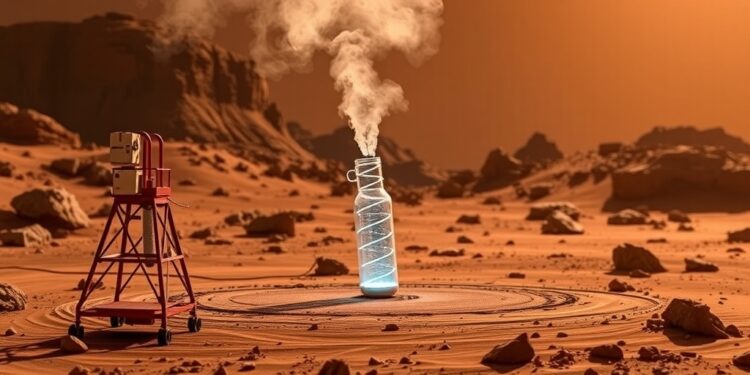To address the pressing issue of global climate change, a groundbreaking method has emerged that promises to make a significant dent in carbon dioxide emissions, the leading contributor to this crisis. Researchers from Nanjing University, alongside their partners from Fudan University, have unveiled a novel electrochemical process designed specifically to split CO2 into its elemental components: carbon and oxygen. The implications are vast—not only for environmental science but for the future of sustainable energy and life support systems in outer space and underwater environments.
For decades, carbon dioxide has been vilified as the cornerstone of climate change, primarily due to the burning of fossil fuels. Traditional methods for reducing CO2 emissions often focus on capturing and storing the gas, but this new approach aims at a fundamental transformation of CO2 itself. The research team successfully demonstrated that CO2 can be split electrochemically with the aid of lithium, marking a significant advancement over previous technologies that have sought to accomplish this feat but have been hampered by high energy requirements and inefficient processes.
In the realm of carbon neutrality, nature has already outlined an efficient process: photosynthesis in leafy green plants, where CO2 is transformed into oxygen and glucose. However, this natural process has its limitations. Mostly, the oxygen released comes from water, not directly from CO2. Significant advancements in technological methods have struggled to match the efficiency of plants in carbon fixation, especially under moderate temperatures and manageable conditions. That is until now.
The research team, led by Ping He and Haoshen Zhou, implemented a sophisticated electrochemical device featuring a gas cathode with a nanoscale cocatalyst composed of ruthenium and cobalt, paired with a metallic lithium anode. This device facilitates a multiphase electrochemical process, where CO2 is initially transformed into lithium carbonate. This intermediate can then undergo further reactions to generate lithium oxide and elemental carbon. The final step in this innovative process involves the electrocatalytic oxidation of lithium oxide, yielding lithium ions and releasing oxygen gas.
What sets this method apart is not just its capability to efficiently split CO2 under relatively mild conditions, but its impressive results as well. The catalyst utilized in this innovative process boasts yield rates exceeding 98.6% for oxygen production, thus dethroning natural photosynthesis as the benchmark for efficiency in producing breathable oxygen from CO2. The team’s trials included testing with pure CO2, as well as mixed gas scenarios that simulate industrial emissions and even the Martian atmosphere, which primarily consists of CO2 under lower-than-Earth pressure conditions.
This research holds profound implications for carbon neutrality plans, especially when powered by renewable energy sources. Imagine facilitating oxygen production on other planets, opening the doors to exploration and habitation on Mars. Moreover, this technology offers real-world applications on Earth, such as enhancing life support systems in underwater environments, breathing apparatuses for certain industrial applications, indoor air purification, and even aiding in the treatment of industrial waste gases.
The timing of these findings could not be more critical. As global awareness of climate change escalates, innovative strategies to mitigate its impacts are urgent. This research not only contributes to the academic discourse on sustainable energy but could serve as a practical solution to the rampant carbon emissions that characterize much of modern industry. The processes behind carbon mitigation technologies are complex, but the team’s approach breaks them down into manageable, controllable steps that future industries may adopt.
Drawing from the experiments and results, the scientific community stands on the brink of a transition. With CO2 emissions continuing to rise, the need for effective technology becomes palpable. This discovery stands as a beacon of hope—providing not just theoretical models for a sustainable future but tangible methods that can be employed in various sectors. The potential for this electrochemical approach is remarkable, merging the urgency of climate action with the advancements in electrochemistry and material sciences.
As researchers continue to refine this process, they will likely explore additional catalysts and optimize product yields, enhancing the method’s viability even further. The next steps may also focus on scaling up these laboratory results for widespread commercial application. The collaboration between academic institutions indicates a proactive approach to engage with this dire challenge, fostering partnerships across disciplines to propel research forward.
In the grand narrative of climate change and our role in mitigating it, the findings from this research group provide a crucial chapter. They signal not just a potential turning point in how we manage CO2 but weave a narrative of innovation and sustainability that resonates beyond academic circles. The reverberations of these discoveries could influence policies, funding allocations, and the very fabric of energy use on our planet.
With continued research and dedication to harnessing renewable energy alongside these advanced electrochemical techniques, the dream of achieving carbon neutrality is coming closer to reality. As scientists iterate on their methods and expand the boundaries of possibility, we have every reason to remain optimistic about forging a sustainable path toward our collective future.
Subject of Research: Electrochemical splitting of CO2 into carbon and oxygen
Article Title: Artificial Carbon Neutrality Through Aprotic CO2 Splitting
News Publication Date: 4-Mar-2025
Web References: DOI link
References: None available
Image Credits: None available
Keywords
Carbon neutrality, CO2 reduction, electrochemical processes, lithium catalyst, oxygen production, climate change mitigation, renewable energy, industrial applications, Mars exploration, sustainable technology.




